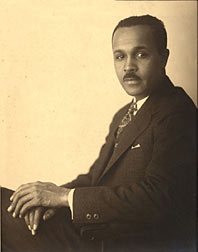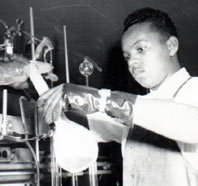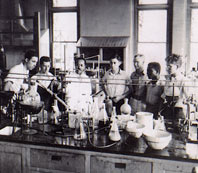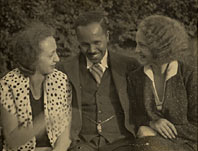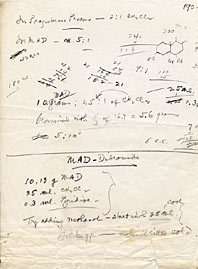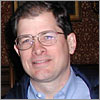The Producer's Story:
Rediscovering a Forgotten Genius
by Stephen Lyons
In 1998, buoyed by the success of the 1996 broadcast of "Einstein Revealed," a
two-hour biography that explored Einstein's personal life as well as his
science, NOVA set out to launch a bigger project using similar production
techniques. We called it Lives in Science: four films that would combine
documentary and drama, each focusing on the life and work of a single
scientist, played by an actor speaking words drawn from the scientist's own
writings.
Looking for an African-American scientist whose story would allow us to explore
the issue of race in science, we considered agronomist George Washington
Carver, biologist E. E. Just, and blood bank pioneer Charles Drew, among
others. But Percy Julian's story stood out. While he'd encountered the same
racial obstacles all black scientists of his generation faced, Julian had
overcome them more successfully than any other African-American in the first
half of the 20th century.
There was just one problem: no book about Percy Julian existed. When producers
set out to make film biographies, they almost always piggyback on years of
research that historians or biographers have already done. But no science
historian had ever studied Julian's career; no biographer had ever told his
story. The literature on Julian consisted of a brief biographical memoir by a
longtime friend, chemist Bernhard Witkop of the National Institutes of Health;
a 1946 Reader's Digest profile; a 1993 magazine article about the Postal
Service's decision to name a stamp in Julian's honor, and scattered press
clippings and Web sites of uncertain reliability.
Getting under way
This was hardly enough to base a two-hour program on, and it meant that before
we could even think about making a film, we'd have to do the kind of original
research that normally goes into writing a book. It was a daunting prospect.
Neither director Llew Smith nor I had a background in chemistry. We didn't know
how long the research would take, how much it would cost, or where the money
could come from. The sensible thing would have been to wait for a Julian book
to come out. But his story was so compelling that NOVA swallowed hard
and plunged in.
Our faith was soon rewarded. In March 1999, the American Chemical Society held
a Julian centennial symposium at its national meeting. The symposium had been
organized by a retired black chemist named Jim Shoffner, whose own career in
chemistry had been inspired by Julian's example, and who had long been working
to call attention to the Julian story. As the symposium was wrapping up, Shoffner
casually mentioned that NOVA was hoping to produce a Julian biography and that
a NOVA representative was in the audience. I stood up to identify myself. Minutes
later, a man named Bob Lichter approached and introduced himself. "I'm the executive
director of the Camille and Henry Dreyfus Foundation," he said, "and we'd like to help."
It was the first sign that others would see the value of telling Percy Julian's
story. By the summer of 2000, a grant from the Dreyfus Foundation—one of
the many generous funders that would ultimately support the
project—enabled us to get under way.
Witnesses
Two members of the Julian team, Meredith Woods and Patricia Garcia-Rios,
focused on building the archival record: combing newspaper and photo archives, libraries,
and databases for popular articles, patent applications,
scientific papers, photographs, and archival film that might be useful for the
program. Meanwhile, Llew Smith and I began a series of oral history interviews.
Though Julian had died 25 years earlier, many people who had known him
personally were still alive.
From all these interviews emerged a portrait of a new Julian,
admirable but also flawed.
In Greencastle, Indiana, seat of Julian's alma mater, DePauw University, we met
Jack and Marion Cook, who had worked for years to call attention to the Julian
story. The Cooks helped us put together a list of 20 known "Julian associates,"
and each time we interviewed one of them we asked, "Who else should we talk
to?" As the list grew to 30 people, then 40, then 50, two historians from our
partners at the Chemical Heritage Foundation joined in the effort. With tape
recorders in hand, we fanned out across the country, learning everything we
could from Julian's family members, friends, former students, and coworkers.
Outside Orlando, Florida, we met 89-year-old Ray Dawson, who described
in vivid detail the work he'd done as a DePauw undergraduate 65 years earlier
to assist Julian in his famous battle with Oxford's Robert Robinson over the
synthesis of physostigmine. To beat the heat of the Greencastle summer, they
had often worked late into the night, then driven out to a little shanty at the
railroad switching yards north of town for coffee and conversation. It was
during one of these late-night talks that Julian told Dawson about his
fiancée, Anna Johnson, who was sending him letters from back East
demanding to know: Are you going to marry me or not?
In Ohio, we discovered former Glidden chemists Helen Printy and Earl
Dailey. They'd had a falling out with Julian and long ago left the chemical
business to open a bar in Cleveland. But when we found them through an Internet
search, all the memories came rushing back. I arrived in town expecting to do a
three-hour interview but stayed for three days.
In Cincinnati, we found Jim Letton, who'd worked for Julian for more
than a decade before returning to school and earning his doctorate in
chemistry. He told heartbreaking stories about graduating from college in 1955
and spending two years in a futile search for a job in chemistry—until he
learned of a Chicago firm called Julian Laboratories where black chemists were
welcome.
In Madison, Wisconsin, Julian's son, Percy Jr., described in chilling
detail the repeated racial attacks his family had faced after moving into the
predominantly white Chicago suburb of Oak Park, and his parents' steely
determination to withstand the pressure to move out.
North of Chicago, we visited Wayne Cole, who'd studied under Julian at
DePauw and then served as his right-hand man at the Glidden Company for more
than a decade. At 86, Cole was gaunt, hunch-backed, and unsteady on his feet,
but when he opened his mouth, out came sentences of astonishing clarity and
precision. Asked about chemical processes he and Julian had used to treat the
soybean 60 years earlier, he described them as if they had happened
yesterday.
Preserving a legacy
Before long, it dawned on us that we weren't just producing a film. We were
preserving the legacy of one of the most significant scientists in American
history—capturing the memories of his closest associates while there was
still time. In the end, we would interview more than 60 people in 13 states.
(We plan to donate the transcripts of our interviews—more than 2,000
pages of them—to a research archive, a priceless resource for future
scholars hoping to study Julian's life and career.)
To a great extent, his story is told by the people who knew him
best.
From all these interviews emerged a portrait of a new Julian, admirable but
also flawed—more complex, more human, and more real than the heroic
figure we'd read about in Reader's Digest. Through these interviews we
also discovered whole new aspects of Julian's story—new details about his
Vienna years, his performance as the star witness in congressional hearings,
and his growing commitment to civil rights, among many others. These new
chapters made his story even more dramatic than the one that had lured us into
the project.
But even as our excitement about the Julian story grew, so did our fear—fear
that we would lose critical eyewitnesses before we could begin production. At this
point, Jim Shoffner came to our aid for the second time. Newly elected to the
American Chemical Society's Board of Directors, Shoffner persuaded ACS to award
the Julian project a special grant. The funds allowed us to return to the 15 best
storytellers we had found in our initial research and record broadcast-quality
video interviews. Just in time, as it turned out: five of those 15 died in the next
three years. But they live on in the film, giving the Julian profile an immediacy
that is rare in a television biography. To a great extent, his story is told by the
people who knew him best.
These people didn't just share their stories. Many also gave us Julian-related
artifacts they'd been holding onto for more than a quarter century, as if
waiting for us to come along. These included letters, postcards, photographs,
even an unfinished autobiography Julian had started 40 years before. Julian's
longtime secretary, Joan Bowman, gave us a precious recording of a speech
Julian had given at Indiana University in 1965 (see Julian Speaks). And from
Peter Walton, a longtime Julian employee and family friend, came the script of
one very special speech entitled "From Beans and Wild Yams to the Wonder
Drugs." In the speech, delivered to an Oak Park church group in 1959, Julian
described his entire scientific career in colorful layman's language.
Fascinating, moving and funny, the speech would eventually become the backbone
of the film, with Tony Award-winner Ruben Santiago-Hudson delivering excerpts
from the speech as Julian's story unfolds.
A collaborative effort
In the end, Percy Julian's television biography got made because NOVA had the
faith and courage to forge ahead in the face of seemingly insurmountable
obstacles, and because we got an extraordinary amount of help along the way.
The film is truly a collaborative effort, made possible by the support of
organizations that also wished to see Julian's remarkable story brought to a
wide audience, and by scores of individuals who contributed to it in ways large
and small. We thank them all. "Forgotten Genius" is their film, too.

